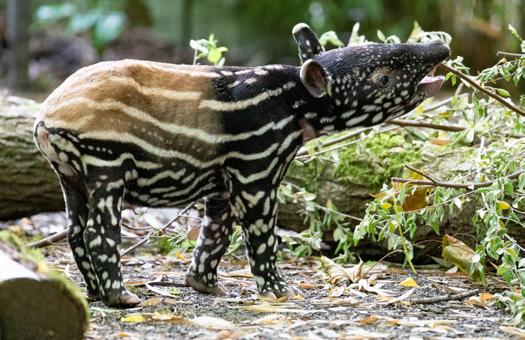Animals have an incredible way of reminding us why conservation matters — and sometimes, it’s the smallest new arrivals that make the biggest impact. That’s exactly the case at Chester Zoo in the UK, where an adorable Malayan tapir calf named Solo recently took his very first steps outdoors. At just over three weeks old, the little explorer is already capturing hearts and symbolizing hope for one of the world’s most endangered species.
A Tiny Star Is Born
Born on July 11, Solo is the first Malayan tapir calf to ever be born at Chester Zoo — a historic milestone for the institution’s conservation program. Under the watchful eyes of his devoted mother, Margery, the energetic youngster made his public debut, exploring the outdoor enclosure and delighting visitors who had gathered to witness the special moment.
Clad in his unique baby coat — a rich dark brown covered with striking white stripes and spots — Solo strutted proudly around his new surroundings. These markings serve as camouflage in the dappled light of the forest floor, helping young tapirs stay safe from predators. As he grows, Solo will gradually lose these patterns and develop the distinctive black-and-white coloration of adult Malayan tapirs.

More Than a Cute Face: Why Solo Matters
While Solo’s first adventure is undeniably adorable, it’s also incredibly important. Malayan tapirs (Tapirus indicus) are classified as endangered by the International Union for the Conservation of Nature (IUCN). Fewer than 2,500 individuals remain in the wild, and their numbers continue to fall due to habitat destruction, poaching, and other human-related threats.
Keepers at Chester Zoo say Solo’s birth is a crucial step forward. By adding valuable new genetics to the European Endangered Species Breeding Programme, Solo helps ensure that tapirs have a future. These managed breeding initiatives act as a “safety net” population, giving scientists and conservationists a fighting chance to prevent extinction.
👉 Read more inspiring animal stories: Full Story: Man Loses 360 Pounds Naturally — Internet Rallies to Support His Next Step

Endangered in the Wild: A Species in Crisis
Malayan tapirs are native to the lush rainforests and tropical forests of Malaysia, Thailand, Myanmar, and the Indonesian island of Sumatra. Sadly, their habitats have been disappearing at an alarming rate. Over the past 36 years, their population has dropped by more than 50%, largely due to widespread deforestation and the conversion of natural forests into palm oil plantations and agricultural land.
But habitat loss isn’t the only threat. Tapirs are also targeted by poachers for their hides, often become victims of road accidents, and are accidentally trapped in snares set for other animals. All of these factors have combined to push the species closer to the brink of extinction.
That’s why each new calf born in captivity — like Solo — represents not just new life, but also renewed hope for an entire species.
A Fascinating and Ancient Animal
Malayan tapirs are remarkable creatures with a lineage that stretches back 20 million years, making them living relics of prehistoric times. They are the largest of the world’s four tapir species and share distant ancestry with horses and rhinoceroses. Despite their size, they are shy, solitary animals that prefer dense forest habitats near water sources.
One of their most distinctive features is their prehensile nose — a long, flexible snout that functions like a small trunk. Tapirs use it to grab leaves, fruits, and shoots from trees and shrubs. They are also excellent swimmers and often take to rivers and streams to cool off or escape predators.
Even their mating rituals are fascinating. Male and female tapirs communicate with an unusual series of wheezing and whistling sounds before sniffing each other and walking in circles — a behavior that eventually leads to mating. These quirky behaviors highlight just how unique and ecologically valuable these animals are.
A Name with Meaning
Solo’s name carries a special significance. He was named after the longest river on the Indonesian island of Java, a region where Malayan tapirs once roamed more widely. The name is a tribute to the species’ heritage and a reminder of the landscapes they depend on — many of which are now under threat.
Solo’s name also symbolizes endurance and resilience — qualities shared by tapirs and the conservationists working tirelessly to save them.
Conservation at Chester Zoo: More Than Just a Birth
Chester Zoo is home to one of the most successful wildlife conservation programs in Europe. Its efforts extend far beyond breeding — the zoo collaborates with global partners to protect natural habitats, rescue injured animals, and educate the public about biodiversity.
The birth of Solo represents a victory for those efforts. It’s a powerful reminder that conservation is not just about saving species in the wild — it’s also about building sustainable populations in human care that can serve as a genetic lifeline for the future.
👉 Read next: The Hidden Meaning Behind Princess Diana’s Cannes Gown – A Heartfelt Farewell to Grace Kelly
Why Tapirs Are Vital to the Ecosystem
Beyond their charm and uniqueness, Malayan tapirs play a vital role in their ecosystems. As herbivores, they act as “forest gardeners,” spreading seeds through their droppings and promoting plant diversity. This process helps maintain the health of tropical forests — ecosystems that not only support countless species of plants and animals but also store vast amounts of carbon and regulate the Earth’s climate.
Losing tapirs would have cascading effects on these ecosystems, underscoring why their protection is so critical.
A Symbol of Hope for the Future
For visitors to Chester Zoo, watching Solo explore the outdoors for the first time is a joyful experience. But for conservationists, it’s also deeply symbolic. Every step he takes represents progress — a small but meaningful stride toward ensuring that future generations will still be able to see tapirs in the wild.
Solo’s story is a powerful example of what happens when science, dedication, and compassion come together. It shows that while the challenges facing wildlife are immense, they are not insurmountable. With sustained effort, collaboration, and public support, we can protect vulnerable species and preserve the rich diversity of life on our planet.
Final Thoughts: Celebrating a Precious New Life
Solo the Malayan tapir may be small now, but his impact is anything but. His first outdoor adventure is not just a milestone for Chester Zoo — it’s a beacon of hope for endangered species around the world. In a time when biodiversity is under threat, moments like this remind us that every new birth, every conservation success, and every dedicated effort counts.
As Solo grows, he will become an ambassador for his species — a living reminder of why we must continue to fight for the survival of the world’s most extraordinary animals.

